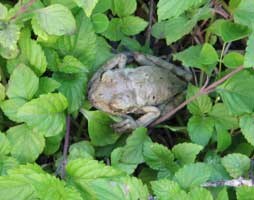|
Toads, frogs, and salamanders, oh my! All of these creatures are amphibians. Sometimes we all need a little help figuring things out, so let's take a closer look at what makes an amphibian an amphibian. 
Imagine for a moment, that you're touching a frog's skin. How would it feel? Now imagine the back of an alligator, with its scaly back. Which animal would have the smooth back and which would have the rough back? It's all about the skin: Second – Since their skin is exposed, they can breathe or exchange gas (oxygen) through their skin (they can still breathe through their lungs too). Third – To keep the skin moist, amphibians prefer moist, humid, and wet homes or habitats. They will also secrete mucus through their skin to help protect the skin and keep it moist. The word amphibian comes from two Greek words amphis and bios which together means double life. That’s because amphibians spend part of their life in the water when they are growing up (like tadpoles) and later, most spend their adult life on land. They will sometimes remain near sources of water, especially when it is time to lay eggs and reproduce. When amphibians lay eggs they need to be near the water. Their eggs, unlike reptiles and birds, have no protective shell or covering. The eggs are jelly-like and can easily dry out on land. When the eggs hatch, it is easy to see that the amphibian young look nothing like their parents. Frogs, toads, and salamanders start their life with no legs, having only a head and a tail. As tadpoles, they grow and develop, eventually losing their tails (in frog and toad cases). At adulthood, most amphibians leave the water and are able to live on land. They typically eat insects, snails and slugs, spiders, and even earthworms. Let's take a closer look at some of the most common Everglades' amphibians. To return to the previous page click on Wildlife and to return to the main |
Last updated: April 14, 2015
